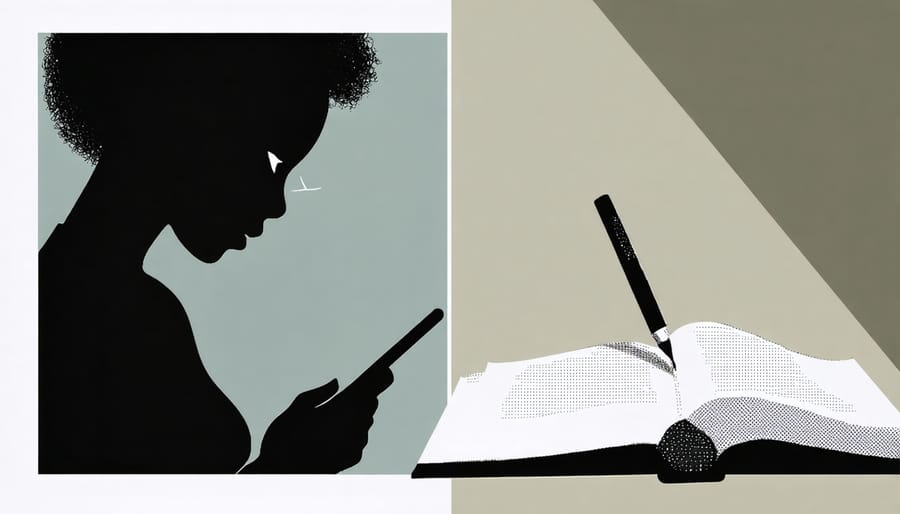
Picture yourself curled up with your journal, not just writing about your day, but actively building your emotional intelligence in our increasingly digital world. As someone who’s transformed my own relationships through mindful journaling, I can tell you that the simple act of putting pen to paper creates a powerful bridge between our online and emotional lives.
When we scroll through social media or send quick texts, it’s easy to lose touch with the deeper emotional currents running beneath our digital interactions. Journal emotional intelligence changes that. It’s like having a personal emotional trainer, helping you decode the subtle nuances of online communication while strengthening your capacity for empathy and self-awareness.
Think of your journal as a private laboratory where you can explore the complex emotions triggered by that cryptic email from your boss or that ambiguous reaction to your latest social media post. By regularly documenting and reflecting on these digital interactions, you’re not just venting – you’re developing a sophisticated emotional vocabulary that serves you both online and offline.
This practice is particularly vital now, as our lives become increasingly intertwined with digital spaces. Through intentional journaling, we can maintain our humanity and emotional depth while navigating the sometimes shallow waters of digital communication. Whether you’re a seasoned journaler or just starting out, combining emotional intelligence with journaling creates a powerful tool for personal growth in our connected world.

The Digital Empathy Gap
Why Text Messages Hide True Feelings
Have you ever sent a text message only to have it completely misinterpreted? You’re not alone. In our digital world, those little blue bubbles often fail to capture the nuanced emotions we’re trying to convey. A simple “okay” can be read as passive-aggressive, while an enthusiastic message might come across as overwhelming.
The challenge lies in what’s missing – those subtle cues we rely on during face-to-face conversations. Body language, tone of voice, and facial expressions all play crucial roles in how we interpret emotions, yet they’re completely absent in text messages. Even emoji, while helpful, can’t fully bridge this emotional gap.
I recently experienced this when texting with a friend about a difficult situation. My attempt at being supportive came across as dismissive simply because the warmth in my voice couldn’t travel through the screen. This experience reminded me why it’s so important to be intentional with our digital communication.
When we rely solely on text messages for emotional conversations, we risk creating misunderstandings that can strain our relationships. That’s why combining digital communication with more personal forms of connection is so vital in maintaining authentic emotional bonds.
The Self-Awareness Challenge
In our hyper-connected world, it’s becoming increasingly challenging to maintain genuine emotional awareness. Between constant notifications, endless social media scrolling, and back-to-back virtual meetings, we often find ourselves operating on autopilot. I remember catching myself responding to emails while on a video call with a friend, completely missing the subtle signs that she was struggling with something important.
This digital overwhelm can disconnect us from our emotional compass, making it harder to recognize and process our feelings authentically. Setting smart digital boundaries isn’t just about managing screen time – it’s about creating space for emotional reflection and genuine connection.
Try this: Next time you feel the urge to immediately respond to a notification, pause for a moment. How does your body feel? What emotions arise? Jotting down these observations can reveal patterns in how digital interactions affect your emotional state. This self-awareness practice helps bridge the gap between our online and offline emotional experiences, leading to more meaningful connections in both spheres.
Your Digital Emotion Journal Practice
Setting Up Your Journal Space
In our fast-paced digital world, creating a dedicated journaling space doesn’t necessarily mean finding a quiet corner with a leather-bound notebook (though that’s lovely if it works for you!). Today’s emotional intelligence journaling can seamlessly blend with our digital lives through thoughtful setup and mindful practices.
Start by choosing your preferred medium – whether it’s a notes app, a digital journal platform, or a traditional notebook. The key is selecting something you’ll actually use consistently. I personally switched from paper to digital journaling when I realized I was more likely to capture my thoughts during my commute or lunch break using my phone.
Create designated time blocks that align with your natural rhythm. Maybe it’s five minutes during your morning coffee, or a quick check-in while waiting for your evening tea to steep. The beauty of digital journaling is its accessibility – you can literally carry your emotional awareness practice in your pocket.
Set up gentle reminders on your phone, but be careful not to make them feel like another obligation. Think of them as friendly nudges to check in with yourself. Consider creating different folders or tags for various emotional themes, making it easier to track patterns and growth over time.
Remember, your journaling space should feel inviting and judgment-free. Whether you’re typing on your tablet or scribbling in a notebook, the goal is to create a consistent practice that fits naturally into your daily digital routine.

Daily Prompts for Digital Emotional Growth
Let’s explore some powerful journaling prompts that can help you navigate your digital interactions with greater emotional awareness. I’ve found these exercises particularly helpful in my own journey of building digital empathy.
Start by reflecting on your most recent social media scroll: How did different posts make you feel? Write about a post that triggered a strong emotional response, exploring not just what you felt, but why you think it affected you so deeply.
Try these daily prompts to enhance your digital emotional intelligence:
1. Today’s Digital Gratitude: List three positive online interactions and why they brightened your day.
2. Screen Time Check-In: How did your digital activities impact your mood today? What patterns do you notice?
3. Digital Boundaries Review: Write about one boundary you’d like to set or maintain in your online life.
4. Connection Reflection: Describe an online conversation where you wish you had responded differently. What would you change?
5. Empathy Exercise: Choose one challenging online interaction and write from the other person’s perspective.
Remember to set aside 10-15 minutes each evening for these exercises. I’ve noticed that consistent practice helps develop a more mindful approach to digital interactions. When I started this practice, I was surprised to discover how much my online behavior affected my emotional well-being.
Consider creating a dedicated “Digital Wellness” section in your journal where you can track your progress and insights over time.
Turning Insights into Action
Once you’ve gathered insights from your journaling practice, it’s time to transform those reflections into meaningful actions that enhance your digital relationships. Start by reviewing your journal entries weekly, looking for patterns in your online interactions. Did you notice yourself reacting strongly to certain types of messages? Were there moments when you wished you’d responded differently?
Create an action plan based on these observations. For instance, if you’ve noticed you tend to respond hastily to work emails when stressed, implement a “pause and breathe” rule before hitting send. Set up specific triggers – like a sticky note on your monitor or a special phone wallpaper – to remind you of your emotional awareness goals during digital interactions.
Try the “digital empathy challenge”: Choose one online relationship each week to focus on improving. Use your journal insights to craft more thoughtful responses, ask more engaging questions, and show genuine interest in their digital sharing. Remember that small changes can make a big difference – even adding an extra moment to consider the recipient’s perspective before responding to a message.
Keep track of your progress by noting positive changes in your relationships. Did a colleague mention appreciating your more measured responses? Has a friend opened up more in your chat conversations? These real-world results will motivate you to continue developing your digital emotional intelligence.
Don’t forget to celebrate your growth – each mindful interaction is a step toward better digital relationships.
Real Benefits I’ve Seen
Better Online Conversations
Have you ever noticed how a simple text message can be interpreted in multiple ways? By applying emotional intelligence principles to our digital interactions, we can improve digital communication and build stronger connections online.
Recently, I caught myself about to send a curt “okay” response to a colleague’s lengthy message. After pausing to journal about my reaction, I realized I was feeling overwhelmed, not annoyed. Instead, I crafted a thoughtful response acknowledging their effort and explaining my need for time to process the information.
Here are some ways journaling has enhanced my online conversations:
Before sending important emails, I take five minutes to write about my intended message and its potential impact. This helps me identify any emotional triggers and adjust my tone accordingly.
When receiving feedback in digital spaces, I journal about my initial reaction before responding. This practice has helped me respond with grace rather than defensiveness.
I’ve started keeping a “digital interaction log” where I note particularly successful online exchanges and what made them work well. This has become my personal playbook for navigating everything from work Slack channels to family group chats.
Remember, the goal isn’t perfection but progress in understanding both our own emotions and those of others in the digital space.
Stronger Virtual Connections
When I first started journaling about my digital interactions, I noticed something fascinating: my virtual relationships began to transform. Instead of merely scrolling and responding with quick emojis, I found myself developing deeper connections with friends and family online. By reflecting on my digital conversations, I became more attuned to the subtle cues in their messages and more thoughtful in my responses.
Journaling helped me recognize patterns in my online communication style and build emotional resilience when facing challenging virtual interactions. I started documenting how certain messages made me feel and why, which led to more meaningful digital exchanges.
For instance, instead of firing off a quick “That’s great!” to a friend’s achievement, I began crafting more personalized responses that showed I truly understood their journey. My virtual friendships deepened as I became more intentional with my words and more present in our digital spaces.
The practice also helped me navigate video calls with more empathy. By journaling about these interactions, I learned to pick up on subtle signs of stress or excitement in others’ voices and expressions. This awareness has been particularly valuable in maintaining close connections with long-distance family members and remote colleagues.
Remember, strong virtual connections aren’t about constant availability – they’re about genuine presence and understanding, even through a screen.

Making It Work Long-Term
Like any meaningful practice, maintaining a consistent journaling routine for emotional intelligence takes dedication and the right approach. I’ve found that treating it like a cherished ritual rather than another task on your to-do list makes all the difference. Start by choosing a time that naturally fits your daily rhythm – perhaps with your morning coffee or during your evening wind-down routine.
Creating a comfortable journaling environment is essential. Whether it’s a cozy corner in your home or a peaceful spot in your garden, make it inviting and distraction-free. I keep my journal, favorite pen, and a warm blanket ready in my designated space, making it easier to maintain the habit.
To keep your practice fresh and engaging, try rotating between different journaling techniques. One week, focus on gratitude entries; the next, explore emotional patterns in your digital interactions. This variety prevents monotony while building different aspects of your emotional awareness.
Remember that consistency doesn’t mean perfection. Some days, you might write pages; others, just a few lines. What matters is maintaining the connection with your emotions and continuing to develop your self-awareness. Building meaningful connections with yourself and others through journaling is a journey, not a destination.
Consider joining a journaling community or finding an accountability partner. Sharing experiences (while keeping private details private) can provide motivation and fresh perspectives. I’ve found that monthly reflection sessions help track progress and adjust your approach as needed.
Set realistic goals and celebrate small wins. Maybe start with three entries per week and gradually increase frequency. Use gentle reminders rather than strict schedules, and be compassionate with yourself if you miss a day. The key is creating a sustainable practice that enriches your emotional intelligence journey for years to come.
As we wrap up our exploration of emotional intelligence journaling, remember that this journey is uniquely yours. By dedicating just a few minutes each day to reflect, write, and connect with your emotions, you’re taking meaningful steps toward greater self-awareness and emotional mastery.
The beauty of emotional intelligence journaling lies in its flexibility and personal nature. Whether you prefer structured prompts, free-writing, or a combination of both, the key is consistency and honesty with yourself. Start small – even five minutes of daily journaling can create ripples of positive change in how you understand and manage your emotions.
I’ve witnessed countless women transform their relationships, career decisions, and self-understanding through this practice. One of my readers, Sarah, shared how her daily journaling practice helped her navigate a challenging career transition by allowing her to process her fears and aspirations more clearly.
Remember, there’s no “right” way to maintain your emotional intelligence journal. Some days might bring profound insights, while others might simply serve as a quiet moment of reflection – and that’s perfectly okay. The goal is progress, not perfection.
I encourage you to start your journaling journey today. Begin with a simple prompt: “How am I feeling right now, and why?” Let your thoughts flow naturally, and be patient with yourself as you develop this new habit. Your future self will thank you for taking this step toward greater emotional awareness and understanding.
Ready to begin? Grab your favorite notebook or digital device, find a quiet space, and let your journey to enhanced emotional intelligence begin.


